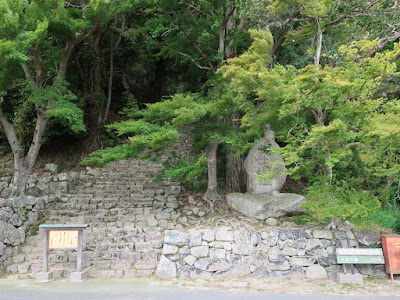Azuchi castle was built by
Nobunaga Oda in 1576 when the internal war continued across Japan. He was a
most possible war lord to rule Japan at that time. The castle tower was 32
meters height and it was six-story above ground and one below. However, it was
burned after death of Oda.
More info. about N. Oda
(Wiki):https://en.wikipedia.org/wiki/Oda_Nobunaga
This
museum is in front of Azuchi station and it is just five minutes away by car
from the ruin of Azuchi castle. It exhibits a one-twentieth-scale
model of Azuchi castle tower. The historical fact, that heros during the
internal war (N.Oda, H.Toyotome, I.Tokugawa and so on) gathered here, moved me
a lot.
After Azuchi castle was
ruined, people moved to Ohmi-Hachiman where the cousin of Toyotomi stationed.
It is near Azuchi.
The photo below is the statue
of Oda in front of the station. The signboard which urges driver a safe drive
is also Oda style.
Azuchi castle museum、安土城郭資料館
安土城は、戦国時代に天下統一を進めた織田信長が、本拠地として4年かけて築城し、1576年に完成した。地下1階地上6階で、天主の高さが約32メートルの巨大な城だったが、信長の死とともに、築後わずか6年で焼失した。
JRの安土駅の前に、本資料館があり、1/20の城の模型を展示している。安土城跡は、資料館から車で5分ほど。信長、秀吉、家康という武将たちがここに集ったかと思うと感慨深いものがある。安土の住民は、城が焼失した後、新しい領主、豊臣秀次が築城した近隣の近江八幡に移り住んだ。
上の写真は、安土駅前の信長の像。その横の飛び出し注意の看板も信長風。町内にもある。ちなみに、この看板は、東近江市が発祥の地だという。
One-twentieth-scale model of Azuchi castle tower: although there are various discussions about the outside and the structure, this model is based on the Dr. Akira Naito’s research.
1/20の模型。外観、構造については諸説あるということだが、内藤昌博士の研究に基づいた模型である。
The model is able to be separated in the center and we can see the elaborate interior. There is a Buddhist tower at the bottom of the castle towr.
城は分割できて、精巧に作った城内が見られる。中央に宝塔がある。
Seven story tower (six-story above ground and one below)
地下一階、地上六階、七層の天主。安土では天守、ではなく、天主と記載するそうだ。
Research
of Dr.Naito、内藤博士の研究
The porcelain panel painting shows you Azuchi, Kyoto and Nagasaki. Model of amors of Oda and his samurai retainers are set in front of the panel. It’s a instagrammable spot.
陶板に描かれた安土、京、長崎の街。その前には、信長とその配下の武将の鎧の複製がおいてある。インスタスポット。
Oda’s history is shown by paper crafts on the second floor. Oda rode on the horse and went to the neighboring territory to meet the powerful father of his possible bride.
二階では、紙人形で信長の人生を紹介している。上の写真は、嫁取りのために、舅になる斎藤道三に会いに行くところ。
Mt. Azuchi (199m-height), where Azuthi castle was, is lower than Mt. Kinugawa(433m-height) where the other war lord had built a castle. So, Azuchi castle was not the best place for a battle, it was a convenient political position. It was around 40 km away from Kyoto which was the capital at that time, so it took just one hour to send his cavalry messenger to Kyoto.
By the way,
Oda abolished monopolies, therefore, merchants near here (Ohmi) expanded business
easily.
安土城がある安土山(標高199m)の横には、繖山(きぬがさやま、433m)があり六角氏の観音寺城があった。安土城下では、楽市楽座が催され、籠もって守るよりも政治のための城だ。織豊政権で商売がしやすくなり、近江商人のビジネスも発展していった。京都まで約40km。馬をとばせば、一時間少々で着く。
Mt. Azuchi and the ruined castle、安土山と城跡
There were no rice field when Oda was alive, it was a lake.
今は水田風景だが、城があった頃は琵琶湖につながる沼地だったそうだ。
The main gate of the castle was here. Must watch the movie on the website below.
http://www.azuchi-shiga.com/n-adutijyouato.htm
安土城への大手道、上記の安土城跡サイトの動画は必見。
Another
gate, Momohashi-guchi is closed now.
百々橋口は通行止め
Rice field after planting and wheat field before hervesting; it is a rich land.
田植え後の水田と、実りつつある麦畑。豊かな土地だ。
Website: http://www.azuchi-shiga.com/n-jyoukakusiryoukan.htm (not official web site, in Japanese), accessed in March, 2020
Reference ( Public museum in Azuchi )Shiga Prefectural Azuchi Castle Archaeological Museum、県立安土城考古博物館
http://azuchi-museum.or.jp/ (in Japanese), accessed in March, 2020
Visited in May, 2019
Previous post (Merchant museums near
here):
Next post :














Comments
Post a Comment